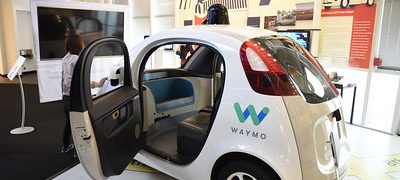Assistive Technology Is A Part of Everyday Life: Transportation
April 6th, 2022, is National Assistive Technology Awareness Day! Congress has designated this day to recognize the role assistive technology (AT) and AT services play in the lives of persons with disabilities. Celebrate AT!
What is Assistive Technology (AT)?
AT is any item, device, or software used to maintain or improve the independence and functioning of persons with disabilities and older adults. AT devices can be “low tech,” such as a built-up handle on a spoon to improve the ability to grasp, to “high tech,” such as computers controlled with eye gaze. AT includes the services necessary to get and use the devices, including assessment, customization, repair, and training.
What services do State and Territory Assistive Technology Act Programs provide?
AT Act Programs assist individuals with disabilities of all ages (including veterans and older adults) to identify and acquire AT that supports their independence, safety, and personal goals. Programs serve AT-users directly and their family members, caregivers, educators, therapists, and employers. Anyone with a reason to learn about AT is welcome.
AT Act Programs provide opportunities to learn about and try out AT. Visitors can compare the functions and features of a range of devices through hands-on exploration. These equipment demonstrations often lead to device loans that help inform future purchase decisions or fulfill a short-term equipment need.
AT Act Programs do not sell new AT. They provide funding counseling and AT financing forassistance with obtaining or purchasing AT. Visitors are not pressured to choose any particular
product or vendor. Service-users learn about devices from AT professionals who may use AT themselves. AT Act Programs also support the reutilization of gently used devices to provide free or affordable equipment. Learn more at AT3Center.net.
How does Assistive Technology support transportation?
For persons with mobility limitations, AT can make the difference between being stuck at home and getting out into the community, attending medical appointments, work, school, and
recreation opportunities. Individuals who use power chairs frequently require a lift-equipped vehicle since their mobility equipment cannot fold and fit in a trunk and the accessibility of public transportation is often unreliable. Assistive technology can also make vehicles operable by persons with gross motor disabilities; and simple AT gadgets can make getting in and out of
automobiles accessible for older adults and others with mobility limitations. AT for transportation is AT for living well.
Examples of AT for Transportation:
- Lift-equipped vans,
- Car seats with specialized supports,
- Spinner knobs or foam grips for accessible steering,
- Tie-down systems for wheelchairs to use lift-equipped school buses,
- Gadgets to assist with entering and exiting an automobile (swivel seat, handybar),
- Portable transfer slings for airline travel,
- Lightweight transport wheelchairs.
A Story from Washington
For years, Roxanne has not been able to travel easily. She has a spinal cord injury that impacts her ability to walk or stand and she uses a wheelchair. She drives, but her wheelchair did not fit in her
sedan and so there was little point to going anywhere. Then her children saved up to buy her a van with updated safety features. Still, she needed an expensive conversion kit to accommodate her wheelchair. While researching these modifications, she learned of the Northwest Access Fund, the state financing partner for the Washington Assistive Technology Act Program (WATAP). With a loan from the Northwest Access Fund, she installed a VMI Northstar conversion with an in-floor ramp and tie-downs. Now she can visit her grandchildren and explore Washington state. Roxanne reports the modified van has exceeded her expectations, improved her mental health, and “will probably extend my life.”
A Story from North Dakota
A mom whose daughter has cerebral palsy sought out the ND Assistive Financial Loan Program to purchase a new modified van to travel wherever their hearts desire. “Our family is very grateful for the loan program,” she told the program. “It’s an easy, straightforward process and has a low-interest rate. The team at ND Assistive was very helpful and shared in our excitement about being able to purchase a newer, wheelchair-accessible van for our daughter. This is our second time using the loan program and would recommend it to anyone who needs to purchase assistive technology
equipment.”
Learn More:
- Vehicle Modifications – Explore AT (at3center.net)
- Loan to Purchase Van Helps UT Family Enjoy the Community Again (at3centerblog.com)
- More than a Van for Blake (at3centerblog.com)
This article was originally posted from the AT3 Center Website.

